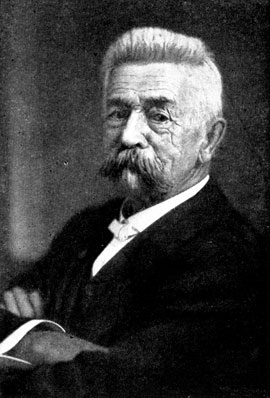|
The ship was full to capacity and
everything was ready for landfall […]. Guided by Cuban
pilots we cautiously approached the chosen spot […] at the
mouth of the San Juan river. There was a full moon to
illuminate us, with just a few clouds in the sky. Suddenly
a cloud blocked the moon. A ray of light managed to filter
through and was reflected right onto the spot where we
were to land[…]
I spotted a Spanish gunboat making for the
river. I informed the leader of the expedition, who
ordered Captain O'Brien to turn around and withdraw. I
returned to the Observation Post and now saw another
gunboat heading towards us. I told Captain Lewis, the
ship’s captain, who calmly replied that I was dreaming, at
which point the first cannon-ball went off […].
I ran and told Captain O‘Brien to put the
ship at full steam in order to evade the gunboats[…],
which were now behind us and closing in. At the same time
I distributed a rifle and ammunition to each volunteer and
told them to take up positions at the stern and fire on
the gun boats […].
Once we
were ready, O’Brien turned the ship to face one of the
gunboats, and when we thought ourselves within range we
opened fire. Unfortunately the first shot missed and we
had to repeat the operation, all the while losing ground
and coming too close to the gunboats. We fired a second
shot and the noise produced by this last cannonade
shattered all the glass in the windows at the ship’s stern
[…] But this shot did us a great service, since when the
gunboats saw that we were well armed they reduced speed,
allowing us to withdraw calmly (Pertierra Sierra
2000:83).
The
Spaniards suffered a number of casualties in the clash.
What was
this floating house like, from which “Dynamite” challenged
the maritime power of Spain, well provisioned by the
United States? Piotr Streltsov, a Russian internationalist
who fought in the Liberation Army at Pinar del Río under
Mayor General Antonio Maceo described the Three Friends
in his memoirs:
[…] she
is a small craft, like a river boat. She can make 18
knots, a speed that allows her to outrun almost all the
Spanish cruisers. This, together with the experience of
her crew, accounts for the fact that, during the two years
of the insurrection, government ships never captured her,
indeed a number of them suffered damage at the hands of
the 'Three Friends'.
Aside
from its engine this ship has no other means of defence,
except for the rare cases when she carries a cargo of
cannons, which are installed at the prow. Like most
American ships, in addition to the upper deck there are
several structures which disfigure the original build of
the 'Three Friends'. Her hold is not large, hence more
than a third of her cargo was stowed on the lower deck,
while the expeditionaries remained on the upper deck (Streltsov
1984: 54).
Stalked by Spies
John
“Dynamite” O’Brien and the other seafaring Cuban
revolutionaries also had to deal with United States spies.
A letter published in the newspaper Cuba y Puerto Rico
denounced the work of these men:
Spies.
A
United States policeman, now turned to spying, was on
board the steamer 'Three Friends', currently at
Jacksonville, during its recent voyage supposedly on a
filibustering expedition. Today he submitted to the
Attorney General the notebook in which he had written down
everything that occurred on board during the voyage. This
report is believed to offer a good deal of evidence of the
ship’s participation in filibustering activity, but the
information is not conclusive nor does it offer the proof
sought by Spain. It is hard to believe that there should
be men so vile and nations which accept espionage as an
institution (González Barrios 1990: 216).
José Antonio Quintana García
|

Dynamite Johnny O'Brien
(Pirie Macdonald in Smith,
Horace, A Captain Unafraid:
The strange adventures of Dynamite Johnny O'Brien,
New York:, Harper, 1912, p. 11). |
Notes
[1] O'Brien
was known as “Dynamite” because during his period as a
filibuster he brought a cargo of six tonnes of the
explosive to Panama. It was a voyage marked by inclement
weather, and by something of a miracle the cargo did not
explode. “Mambí” was an anti-Spanish rebel in the
nineteenth-century wars of independence of Santo Domingo
(Dominican Republic) and Cuba.
References
- Castellanos García, Gerardo. Tierras y glorias de
Oriente (Havana: Editorial Hermes, 1927).
- García del Pino, César. Expediciones de
la guerra de
independencia, 1895-1898
(Havana: Editorial de Ciencias Sociales, 1996).
- González Barrios, René. En el mayor silencio
(Havana: Editora Política, 1990).
- Pertierra Serra, Enrique. Italianos por la libertad
de Cuba (Havana: Editorial José Martí, 2000).
- Streltsov, Piotr P., Diario de un mambí ruso.
Edited by Ángel García and Piotr Mironchuk (Havana:
Editorial de Ciencias Sociales, 1984). |

